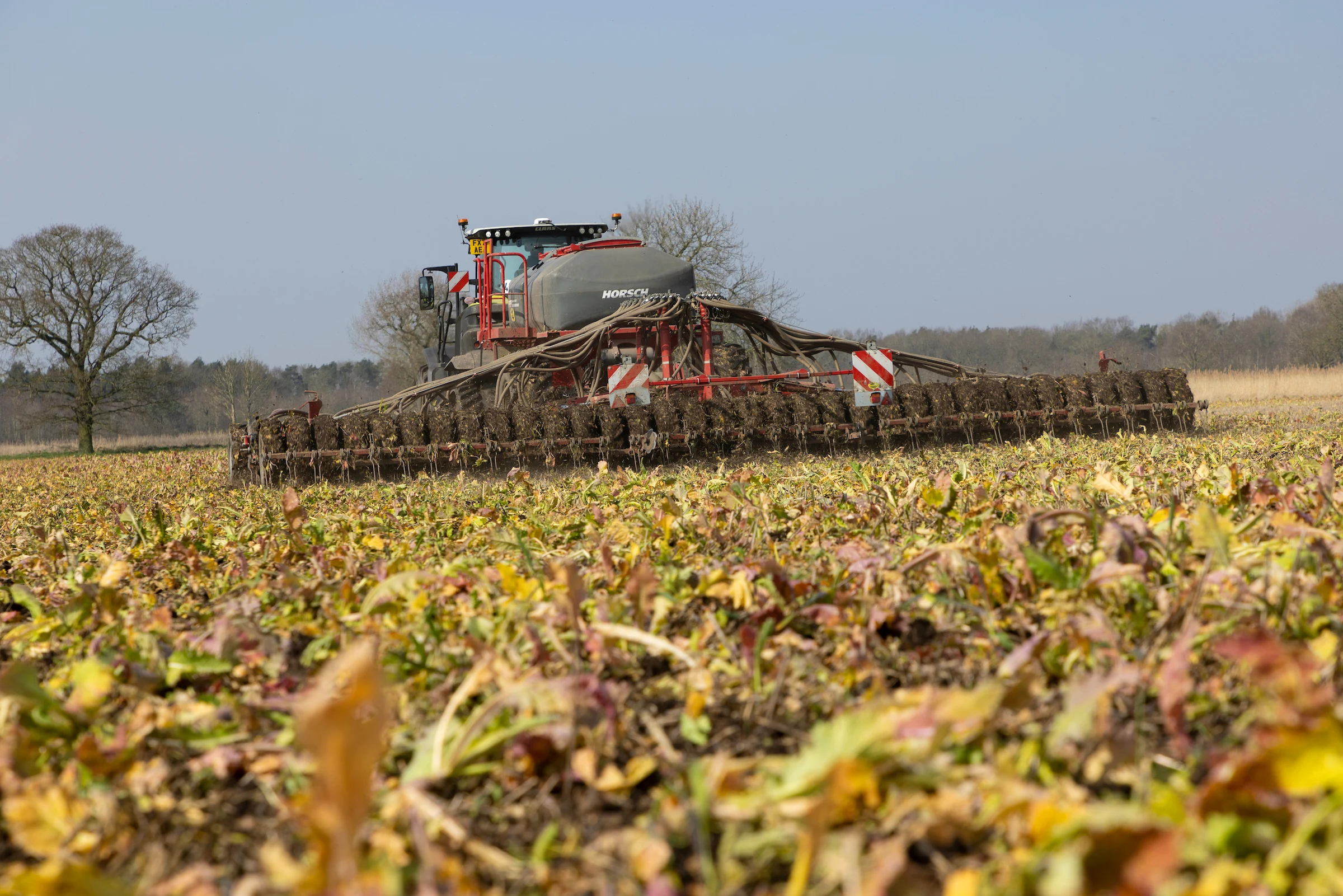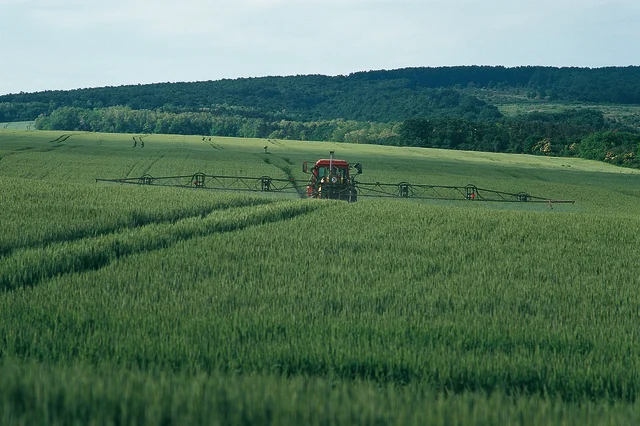Published on 7th February 2022
Weed Management
Top Sprayer Tips: Best practice advice for spraying off overwintered stubbles and cover crops with glyphosate

Spraying off overwintered stubbles
Spraying off overwintered stubbles with glyphosate is a job which can be, perhaps, inadvertently rushed in the race to get land prepared for drilling in the spring, says Roger Bradbury, Bayer’s Market Development manager for cereals.
“The most critical reason why you want to spray off stubbles before spring crops is for grass weed management,” he says. “If you don’t get the glyphosate application right, depending on how you establish the following spring crop, there’s the risk of transplanting grass weeds into a crop where they are harder to control.”
It’s also important for the long-term efficacy of glyphosate to concentrate on effectively applying it, he says. “There is no known resistance to glyphosate in the UK, but the risk is there. Application is important to make sure what is put in the tank arrives at the target to do the job.
“Poorer application potentially means more chance of weeds surviving glyphosate applications and increasing the risk of resistance developing, particularly in grass weeds.”
Typical overwintered stubbles are a little more challenging than those in the autumn. “To get the best coverage with glyphosate and best performance you want to be trying to treat weeds when they are small, and the likelihood is that the weeds will be bigger in the spring,” explains Mr Bradbury.
While grass weed control is the typical driver for stubble sprays, overwintered stubbles are likely to have a range of weed types, potentially also including more challenging broadleaf weeds, such as volunteer oilseed rape and cranesbill.
“Conditions will likely be cooler in the early spring than autumn, so not as ideal as they might be in the early part of autumn.”
That all adds up to an application to bigger weeds, including potentially tillering grass weeds and a denser canopy or mat of green material to spray in more challenging conditions.
In the main the target is likely to be a bit clumpy, more prostrate, albeit with the potential for some taller targets, such as volunteer oilseed rape. “That’s an important point thinking about timing – stubble sprays need to be before stem extension to ensure you get best efficacy from the glyphosate.”
Application characteristics
Those field characteristics mean that good coverage of as much of the target as possible is crucial, says Agrii regional technical adviser David Felce, who also farms 97ha near St Neots in Cambridgeshire.
“I often find a mid-range water volume of around 150 L/ha gives you good coverage of a slightly denser canopy, without sacrificing concentration too much.
“That will give you good overall coverage of a larger target weed so you have more points where glyphosate is being translocated. If you only target the top bits of weeds, the glyphosate has a lot more work to do to get down to the roots.”
Nozzle choice requires careful assessment of the field – if small grass weeds are starting to emerge that might change requirements. “It’s about droplet spectrum – typically for glyphosate you want a medium or medium-coarse spray, but if you’re targeting smaller grass weeds, it will need to be on the finer side,” Mr Bradbury says.
“But where you have a denser canopy, a coarser spray will produce bigger droplets that are less prone to drift. They also stay in the liquid phase a bit longer, giving more time for the glyphosate to move through the stomata into the leaf, reducing evaporation and leading to better uptake.”
Where a coarse spray is used air induction or pre-orifice nozzles are good options, or alternatively slightly larger flat fans operating at lower pressure, Mr Felce says.
A sensible forward speed for this type of application would be 10-12 km/hr, Mr Bradbury suggests. “It’s not what growers will want to hear – they’ll want to be going 16 km/hr or faster, but it will increase the risk from drift, increase turbulence behind the cab and the boom, so you get uneven spray deposition in the field. It just increases the chances of a poor result.”
The field surface will dictate how fast you can go to some extent, and how good your boom suspension is, Mr Felce adds. “You want to go at the speed you can maintain a constant boom height.”
Ideally with overwintered stubbles you’re aiming for just one application, both agree. “But depending on shading of emerging weeds or the interval pre-drilling, you might need a second one,” Mr Bradbury notes.
“But it is important to avoid repeat doses directly onto surviving weeds – the fewer times you can expose weeds to glyphosate the better, so do some form of cultivation before a second application.”
If a second application is necessary, the water volumes can be closer to 100 L/ha, and with smaller weeds the target a medium quality spray with angled nozzles would be the changes Mr Felce would advise in sprayer set up.
For timing, Mr Bradbury suggests leaving it as close to drilling as possible to help reduce the grass weed burden. “Ideally it would be within a week of drilling, but if you have perennial weeds, they might need a longer period of time before drilling.”
What about cover crops?
Overwintered cover crops tend to be much bigger and bulkier than overwintered stubbles. That means a couple of important differences from overwintered stubbles.
First, timing, especially ahead of spring cereals, should be at least four weeks ahead of drilling to give time for the biomass to degrade before planting into it. Evidence suggests that leaving that type of interval allows the soil to recover, dry out and reduces the chances of a yield penalty in the following crop.
Cover crops, especially large, bulky ones with more difficult to control species, may need two applications – again, especially if grass weeds emerge after the first application.
For the initial spray, water volumes need to be a bit higher than for overwintered stubbles – around 150-200 L/ha, rather than 120-150 L/ha, Mr Bradbury suggests.
Spray quality should be more at the medium-coarse end for the bigger droplets to penetrate the canopy, with angling nozzles also worth considering.
If a second spray is required, it is likely to be similar to a second overwintered stubble application where targeting smaller grass weeds is the key.
Latest research
Agrii research has highlighted the benefits of using a Roundup-branded formulation versus a generic glyphosate in overwintered stubbles. The trial compared Roundup Powermax with Ardee XL both alone and in combination with a plant-based adjuvant, the coco-amine C80, or Volta Ego, a water conditioner / adjuvant. The application was carried out with a purpose-built tractor mounted sprayer, to replicate the dynamics of in-field spraying.
“Overall Powermax is better than Ardee whatever you do with it,” Mr Felce says.
“What was slightly contrary to what you might expect, is the Powermax responded better than the generic to additional adjuvants. The generic didn’t seem to respond to adjuvants in terms of speed of kill, whereas the Powermax is improved particularly by the addition of C80 – increasing control from 62.5% 28 days after application to 72.5%.”
After 42 days, all the Powermax treatments had reached 98.5% control of black-grass, while Ardee alone was 93.25%. “You can improve the medium-term performance of the generic by the addition of the adjuvants.”
Weed re-growth with Powermax is also reduced using adjuvants, and again is always better than the generic with or without adjuvants, he adds.
The trial also compared performance against charlock – a brassica weed Mr Felce suggests can be used as a proxy for control of some cover crop species.
Against this more difficult to control weed, there was a greater difference in the performance of Powermax versus the generic, with 10% improvement after 28 days, 12.5% after 42 days, and 0% regrowth compared with 12.5% with the generic.
Best practice guidance with overwinter stubbles
Higher water volumes (120-150 L/ha) to aid coverage
Medium to coarse droplet pattern to increase penetration and reduce drift
Slow down to a forward speed where you can maintain constant boom height
If need second application – precede with some form of cultivation to avoid retreating survivors, reduce water volume to 100 L/ha, with fine-medium spray and angled nozzles
Best practice for cover crop destruction
Higher water volumes around 150-200 L.ha
Medium-coarse droplet pattern, unless targeting emerging weeds
Second sprays more likely to be required – reduce water volume to 100 L/ha, fine-medium spray if targeting small grass weeds, angled nozzles
Available now, the next blog in the series of Top Sprayer Tips for the Season Ahead focuses on maximising the efficacy of spring grassweed herbicides in wheat.




